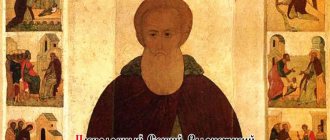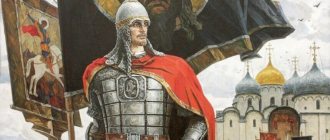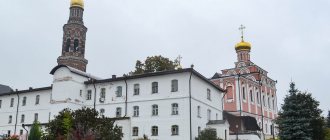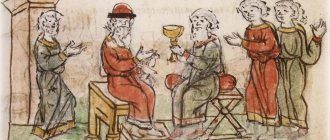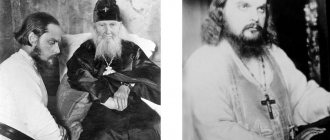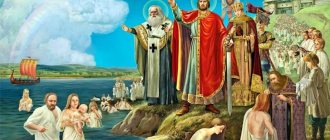- Reports and messages
- Story
- Saints in Rus'
There are many saints known in Rus', whose miracles still amaze the minds of their contemporaries.
One of the most famous saints in Rus' can be called Sergius of Radonezh. He is the founder of the Trinity Monastery (currently the Trinity - Sergius Lavra). Sergius did a lot for the prosperity of spiritual life. He was a man who sincerely loved his homeland and believed in spiritual kindness. Manuscripts of his associates have survived to this day, for example, “The Life of Sergius of Radonezh,” written by Epiphanius the Wise.
Seraphim of Sarov, an elder who lived in the mid-17th century. Even in early childhood, miracles often happened to the boy; once he could not resist and fell from the bell tower of the temple, which was the height of a three-story building. Everyone was amazed that such a fall did not leave even a scratch on the boy. After the fateful meeting of young Prokhor with the elder Dosifei, who showed the young man the path of life. Prokhor took monastic vows and became a minister of the Sarov Monastery, and his name also changed from Prokhor to Seraphim. One night the elder dreamed of the image of the Mother of God; she asked him to host people. Seraphim followed his dream, and soon people began to notice the miraculousness of the saint’s prayers. Some of his advice to people seemed strange at first, but following them later, they understood that the glory of the monk was righteous.
Blessed Matrona of Moscow, probably everyone knows about the miraculousness of the icon depicting the Matrona of Moscow; by touching the relics of the saint, even a barren person can give birth to a child, and a terminally ill person can receive healing. From early childhood, Matronushka was unable to see the images of God and the devil, but at the same time she was blind from birth. When the girl was 17 years old, trouble happened in their family, her mother’s legs gave out, doctors said that she would no longer be able to walk. Soon another misfortune overtook the girl; she had nowhere to live. And then she and other believers fell under the revolution over the saints, but she did not abandon the church. Prayer was a faithful companion in the difficult journey of life. After the revolution, sick, paralyzed and blind, she still continued to host people and instruct them on the path of God.
The icon with the image of Xenia of St. Petersburg helped more than one thousand people; the only thing with which the miraculousness of the icon can be compared is with the Matrona of Moscow. At the first stage, Ksenia’s life was no different from other people, it all started after the death of her beloved husband, the young woman became despondent, to some extent she blamed herself for the death of her husband, she even had thoughts of saying goodbye to life. One day, Ksenia left her house to poor people, and she herself went to live in an old dilapidated hut, completely abandoning worldly goods. For people, even of that time, this was a truly strange act. How exactly Ksenia came to serve the church is still not known; the only thing that is said in the manuscripts is that the gift of foresight was revealed after the fire. What subsequently led the woman to serving God.
4th grade
Popular message topics
- The Animal Kingdom
The Animal Kingdom is rich in animal species, they are all different, they all live and eat in their own way. Each family has its own specific task that they perform. For example, predatory insects cleanse the world of pests, - Badger
A badger is a mammal that is similar in size to a medium-sized dog. The badger is a member of the mustelidae family. The badger is distributed throughout all parts of Europe, but does not live in some northern regions. The badger also lives in the Caucasus - Opossum
In the order of marsupials there is such an animal as the opossum. The most common North American opossum. He is small and is constantly compared to a cat. Its color is gray and there is no hair on the tips of its ears.
The criteria for determining spiritual achievement in Orthodoxy are very strict. We present the 10 most revered saints canonized by the Russian Orthodox Church.
Boris and Gleb
(unknown -1015)
The first Russian saints. Sons of the Kyiv prince Vladimir and the Byzantine princess. Born around 990. Upon reaching adulthood, they converted to Christianity. In 1015, Vladimir sent Boris to repel a Pecheneg raid. The prince did not meet any enemies, but on the way he learned about the death of his father, and also that the Kiev throne was occupied by Svyatopolk, who wants to kill him. The warriors suggested that Boris go to Kyiv. He refused to take up arms against his older brother. Svyatopolk sent assassins to Boris, but even then the prince forbade raising weapons for defense. Later, killers were sent to Gleb. He already knew about his brother's death and the impending danger. But, like Boris, he forbade the vigilantes to shed blood and died. The brothers were canonized in 1039 as passion-bearers, which emphasizes their acceptance of martyrdom not at the hands of the persecutors of Christianity, but from their fellow believers. Their martyrdom consists of goodness and non-resistance to enemies. Memorial Days: May 15, August 6 and September 18 (hereinafter dates according to the new style).
Vladimir the Baptist
(about 960-1015)
Son of the Kyiv prince Svyatoslav. First he reigned in Novgorod, and in 978 he seized the Kiev throne. In 988 he adopted Christianity according to the Greek model and made it the official religion of Kievan Rus. At baptism he received the name Vasily. He was glorified among the saints as Equal to the Apostles - for preaching the Gospel and converting an entire people to Christianity. The exact date of canonization is unknown, but not earlier than the middle of the 12th century. Memorial Day: July 28. Also revered by the Catholic Church.
Mikhail Chernigovsky
(1179-1246)
Prince of Chernigov, from 1238 - Grand Duke of Kiev. Participated in the Battle of Kalka. In 1246 he was summoned to the Horde. Before entering Batu's tent, the Mongol priests ordered him to walk through the sacred fire and bow to their idols. Michael replied that “a Christian does not serve either fire or deaf idols.” For refusing to worship, the prince was executed. Canonized in 1572 as a martyr. Memorial Days: February 27 and October 3.
Alexander Nevskiy
(1221-1263)
Prince of Novgorod, Kyiv and Vladimir. Having won important victories, he stopped the expansion of Sweden and the Teutonic Order into Rus'. He tried to maintain peace with the Horde, sometimes cruelly forcing his subjects to do so. In 1262, he was summoned to the headquarters of Khan Berke, who wanted to force Rus' to send an army to march on Iran. I was able to dissuade Berke, but fell ill on the way home. Before his death, he took monastic vows under the name Alexy. Canonized in 1547 as a miracle worker. Memorial Days: June 5, September 12, December 6.
Sergius of Radonezh
(1314-1392)
In the world Bartholomew. Spiritual mentor of many princes, including Dmitry Donskoy and his father. He reconciled the warring Russian rulers, persuaded them to submit to the power of Moscow. He was revered in Rus' as the “spiritual collector of the Russian people.” Founder of a number of monasteries. Canonized in the middle of the 15th century as a saint, that is, those who pleased God through obedience, asceticism and monastic feats. Memorial Days: July 18 and October 8. Since 1969 it has also been venerated by the Catholic Church.
St. Basil the Blessed
(1469-1557)
From peasants. He had the gift of foresight. At the age of 16, he set out to wander and accepted the feat of foolishness. In the Orthodox tradition, this is a kind of religious asceticism, accompanied by a complete renunciation of material wealth. Rumor attributes many miracles to Vasily. Canonized in 1588. Memorial Day: August 15. The Intercession Cathedral on Red Square is usually called St. Basil's Cathedral.
Stefan Permsky
(around 1340-1396)
The worldly name is unknown, the father was a priest. The birth of Stephen as “the bishop and teacher of Perm” was predicted by the righteous Procopius of Ustyug. Stefan can be called the first Russian missionary. He preached the Christian faith in the Komi lands, created an alphabet for them and translated spiritual literature into their language. The Russian Orthodox Church is revered in the guise of its saints. Canonized by the Council of 1549, however, in the Perm land he was revered as a saint during his lifetime because of the miracles attributed to him. Memorial Day: May 9.
Ksenia Petersburgskaya
(between 1719/1730 - no later than 1806)
From the nobles. After the early death of her husband, she accepted the feat of foolishness. She donated all her property to the poor. She led a strictly ascetic lifestyle. With age, Ksenia discovered the gift of foresight. She predicted the death of Elizabeth Petrovna, Ivan Antonovich, Paul I. She was canonized in 1988 as a saint (in a broad sense, this is anyone who enjoys the vision of God and communicates with Him). Memorial Days: February 6 and June 6.
Neil Sorsky
(1433-1508)
Origin unknown. He called himself “ignorant and a peasant,” but, apparently, he received a good education. He took monastic vows at the Kirillo-Belozersky Monastery in the mid-1450s. He occupied a prominent position in the monastery. Together with several students he made a difficult pilgrimage to Palestine and Syria. Upon his return, he founded a monastery on the Sora River. A major Orthodox theorist, founder of the monastery movement. He criticized the church for the excessive pomp of rituals. Canonized no later than the end of the 17th century as a saint. Memorial Day: May 20.
Seraphim of Sarov
(1754-1833)
In the world Prokhor Mashnin. From a wealthy merchant family. After several signs he took monastic vows. From 1794 to 1810 he lived in the forest, taking upon himself a number of difficult vows, including silence. Legends attribute many miracles to him. He returned to the monastery, but lived as a recluse and died while praying. Canonized in 1903 as a saint (for monastic feat). Memorial Days: January 15 and August 1.
Modern canonizations
The beginning of the modern period in the history of canonizations carried out by the Russian Orthodox Church can be considered the Local Council held in 1917-18, by which the universally revered Russian saints Sophrony of Irkutsk and Joseph of Astrakhan were canonized. Then, in the 1970s, three more clergy were canonized - Herman of Alaska, Archbishop of Japan and Metropolitan Innocent of Moscow and Kolomna.
In the year of the millennium of the baptism of Rus', new canonizations took place, where Xenia of Petersburg, Dmitry Donskoy and other, no less famous, Orthodox Russian saints were recognized as pious.
In 2000, the anniversary Council of Bishops took place, at which Emperor Nicholas II and members of the Romanov royal family were canonized “as passion-bearers.”
Byzantine rules of canonization
In the 17th century, the Russian Orthodox Church succumbed to the influence of the ancient Byzantine rules for canonization. During this period, mainly clergy were canonized because they had church rank. Missionaries carrying the faith and associates in the construction of new churches and monasteries also deserved to be counted. And the need to create miracles has lost its relevance. Thus, 150 righteous people were canonized, mainly from among the monks and high clergy, and the Saints added new names to Russian Orthodox saints.
Venerable Euphrosyne of Polotsk (1100–1173)
The eldest daughter of the Vitebsk prince Svyatoslav Vseslavich and the granddaughter of the famous Polotsk prince Vseslav Bryachislavovich, the beautiful Predslava became a nun in her youth - against the will of her parents, who wanted to marry her off profitably.
Having received a monastic name in honor of the Venerable Euphrosyne of Alexandria, she became famous not only for her spiritual exploits, but also for her extensive educational activities. Having settled in the Hagia Sophia Cathedral, the cathedral church of Polotsk, she was busy copying liturgical books. Later she founded male and female monasteries and until the end of her days she took care of ordinary people.
At the end of her life, already in old age, the Monk Euphrosyne fulfilled her long-standing desire - she visited the holy places of Byzantium and Palestine.
Her father, exiled by the Kyiv Grand Duke Mstislav I Vladimirovich in 1130, was buried in Constantinople. Having reached Constantinople, Euphrosyne received the blessing of Patriarch Luke Chrysovergas, prayed in the Church of Hagia Sophia, venerated the Constantinople shrines, visited the graves of her father and her other relatives and, having rested, continued her journey to the Holy Land.
Having reached Jerusalem, the Venerable Euphrosyne, as her life tells us, “bowed at the life-giving Tomb of Christ, then placed a golden candile (candlestick) at the Tomb and brought many gifts to the Church of Jerusalem and the Patriarch.” In the Church of the Resurrection of Christ, the Venerable Euphrosyne, in her prayers to the Savior, asked that He allow her to complete her life’s journey in this holy place.
The saint’s prayer was heard by the Lord. Soon she became seriously ill and even, despite her ardent desire to visit the holy River Jordan, she was no longer able to make a pilgrimage there. Euphrosyne's brother and sister went to worship the holy waters of the Jordan without her and brought Euphrosyne water from the Jordan, which brought joy to the dying woman beyond words. After some time, she died peacefully in the arms of her family and was buried in a monastery near Jerusalem. Since the end of the 17th century, the relics of Saint Euphrosyne rested in the Far Caves of the Kiev Pechersk Lavra, and in 1910 they were transferred to Polotsk, where they remain to this day.
Russian saints
The feat of foolishness or blessedness is one of the most difficult spiritual paths in Christianity. People follow them for the sake of God, but under the secret spiritual guidance of experienced monastic mentors and spiritual fathers.
It was only in Ancient Rus' that holy fools began to be called “blessed.” Foolishness is a spiritual feat of voluntary, for the purpose of salvation and pleasing Christ, renunciation of the world, pleasures and pleasures, but not in monasticism, but being “in the world”, but without adhering to generally accepted social norms. The holy fool takes on the appearance of an insane or unreasonable, naive person. Many people swear and mock such fools - but the blessed always endure hardships and mockery humbly. The goal of foolishness is to achieve inner humility, defeat the main sin, pride.
However, over time, the holy fools, having reached a certain spiritual level, denounced sins in the world in an allegorical form (verbally or in action). This served as a means of humbling oneself and humbling the world, improving other people.
The most famous Russian blessed ones are Saint Basil, a Moscow miracle worker who lived during the time of Ivan the Terrible, Saint Ksenyushka and Saint Matronushka.
Xenia the Blessed is one of the most revered and beloved saints by the people. “Ksenyushka” - many affectionately called her during her lifetime, and they still do now, when she helps us from Heaven with her prayers. She lived relatively recently - in the 18th century (after all, many revered saints to whom the entire Church prays lived in the first centuries of our era, at the dawn of Christianity).
Blessed Xenia was very famous in St. Petersburg in the 18th century. After the death of her husband Andrei. St. Andrew's Church on Vasilyevsky Island, she gave away all her property and feigned madness - she began to call herself by her husband's name. In reality, she did not want her, a young widow of 27 years old, to be married off by her relatives, and was only concerned about the afterlife fate of her beloved husband. She prayed for their life together in Heaven, for the Lord to accept her beloved husband into the Kingdom of Heaven. For the sake of love for her husband and for God, she accepted the feat of poverty and foolishness (imaginary madness), and received from the Lord the gift of prophecy and healing.
Matronushka, blessed Matrona, Saint Matrona of Moscow - all these are the names of one saint, revered by the entire Orthodox Church, beloved and dear to Orthodox Christians around the world. The saint was born in the 19th century and died in 1952. There are many witnesses to her holiness who saw Matronushka during her lifetime. Even monks from the Trinity-Sergius Lavra came to her for spiritual advice and consolation.
Matronushka still helps those who pray today; there are many testimonies about miracles after prayers in front of her icons and relics in the Matrona Church on Taganka and about the appearances of blessed Matrona in dreams to believers.
May the Lord protect you with the prayers of all Russian saints!
Venerable Epiphanius the Wise (†1420)
Most of all, this saint is known as a church writer, the author of the very first life of St. Sergius of Radonezh. He lived for a long time in the Trinity-Sergius Monastery and was one of the disciples of St. Sergius.
After the death of his teacher, Epiphanius moved to Moscow. While living in the capital, he continued to be engaged in literary activities and wrote two wonderful and widely known literary and biographical works - “The Life and Life of St.
our God-bearing father Sergius" and "A Sermon on the life and teaching of our holy father Stephen, who was a bishop in Perm." Both of these lives became very popular among the people and are still constantly republished.
In the period between 1415 and 1417, the Monk Epiphanius made a pilgrimage from Novgorod the Great to Jerusalem and left us a brief description of his journey. “The Tale of Epiphanius Mnich <monk> about the path to the holy city of Jerusalem” has reached our time in several copies of the 16th and 17th centuries. Judging by the text of the legend, the path of the Monk Epiphanius began in Novgorod the Great, through Velikiye Luki he went to Polotsk, then to Minsk and further through Slutsk to Belgorod on the Dniester and along the Black Sea to Constantinople, and then to the Holy Land.
About his stay in Constantinople, Jerusalem and on Athos, the Monk Epiphanius writes, using the traditional method of hagiographic literature of the author’s self-deprecation and contrasting himself as a sinner with the holy ascetic Sergius: “St. Sergius did not seek the reigning city of Constantinople, nor the Holy Mountain. Athos> or Jerusalem, as if I were accursed and devoid of reason. Alas, be cruel to me! Crawling here and ovamo <here and there> and swimming through judgment and ovudu <here and from here>, and moving from place to place...” Apparently, during the pilgrimage, Epiphanius realized with renewed vigor that sometimes it is easier to find God while sitting in his own home. cell than traveling to distant lands.
Therefore, after returning from the pilgrimage, Epiphanius the Wise again settled in the Trinity-Sergius Monastery, where he completed work on the life of St. Sergius of Radonezh, known to us. Epiphanius died shortly before the discovery of the relics of St. Sergius, but the life he wrote played a big role in the church-wide veneration of the great Russian saint.
What is canonization
The church procedure for canonizing a righteous person is called canonization. She encourages believers to honor a recognized saint in public worship. As a rule, ecclesiastical recognition of piety is preceded by popular glory and veneration, but it was the act of canonization that made it possible to glorify saints by creating icons, writing lives, and compiling prayers and church services. The reason for official canonization can be the feat of a righteous person, the incredible deeds he has performed, his entire life or martyrdom. And after death, a person can be recognized as a saint because of the incorruption of his relics, or miracles of healing occurring at his remains.
In the event that a saint is venerated within one church, city or monastery, they speak of diocesan, local canonization.
The official church also recognizes the existence of unknown saints, the confirmation of whose piety is not yet known to the entire Christian flock. They are called revered departed righteous people and requiem services are served for them, while prayer services are served for canonized saints.
That is why the names of Russian saints, who are revered in one diocese, may differ and be unknown to parishioners of another city.


